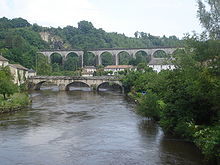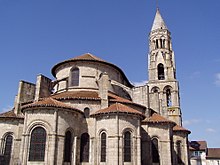Saint-Léonard-de-Noblat
| Saint-Léonard-de-Noblat | ||
|---|---|---|

|
|
|
| region | Nouvelle-Aquitaine | |
| Department | Haute-Vienne | |
| Arrondissement | Limoges | |
| Canton | Saint-Léonard-de-Noblat (main town) | |
| Community association | Noblat | |
| Coordinates | 45 ° 50 ′ N , 1 ° 29 ′ E | |
| height | 250-444 m | |
| surface | 55.59 km 2 | |
| Residents | 4,554 (January 1, 2017) | |
| Population density | 82 inhabitants / km 2 | |
| Post Code | 87400 | |
| INSEE code | 87161 | |
| Website | http://www.ville-saint-leonard.fr | |

|
||
Saint-Léonard-de-Noblat ( Occitan : Sent Liunard ) is a French village with 4554 inhabitants (at January 1, 2017) in the Haute-Vienne in the region Nouvelle-Aquitaine . It belongs to the arrondissement of Limoges and is the main town ( chef-lieu ) of the canton of the same name .
geography
The small town is the eleventh largest municipality in the Haute-Vienne. It is located on the north bank of the Vienne River on the D 941 department road, 21 km east of Limoges .
history
Saint-Léonard is located at the junction of an important road from Bourges to Bordeaux over the Vienne, which existed before the Roman conquest. The Pont-de-Noblat bridge south of the city dates from the 13th century. A castle owned by the Bishop of Limoges was tasked with controlling this road. In the 12th century it became an important stage on the Via Lemovicensis , one of the four historical " Routes of the St. James pilgrims in France " to Santiago de Compostela .
The veneration of St. Leonhard has its origins in the 11th century, when a biography with strongly legendary features was written. According to her, he first lived at the court of King Clovis I towards the end of the 5th century , before he left the latter to become a hermit . He was not far from Limoges and the tomb of St. Martial in the forest of Pauvain, on the banks of the Vienne. According to legend, the King of Aquitaine gave him part of the forest as a thank you for the intercession at the birth of his child. Leonhard has a chapel there in honor of the Virgin Mary and St. Remigius erected. Over time, more and more people came to see him, and prisoners who had been released through his intervention asked for asylum from him. Leonhard was buried in the chapel he had built.
The veneration of St. Leonhard quickly spread throughout Christendom; his grave became a place of pilgrimage. Many famous people came to pray at his grave:
- Bohemond of Taranto (1106)
- Richard the Lionheart (ca.1197)
- Charles VII and his son, who later became Louis XI. (1438)
- Eleanor of Austria , wife of Francis I (1541)
- Henry II of Bourbon-Condé (1620)
- Anna of Austria thanked for the birth of Louis XIV.
- Tsarina Alexandra , wife of Nicholas II , sent a representative to visit the tomb of St. Leonhard to pray for the birth of an heir to the throne.
The pilgrimage tradition originated at the beginning of the 11th century; the Liber Sancti Jacobi explicitly recommends that the pilgrims visit the grave. To protect the relics and to welcome pilgrims, clergymen founded a monastery in 1105. Since the 12th century, the place has been enclosed with moats and walls. Two different quarters developed: the one dedicated to cult and administration around the collegiate church, with the hospital and the town hall, and that of the traders around the market halls.
In 1183 the place was attacked by robbers, the Paillers . A few years later he was taken by the Duchy of Brabant . The English King Johann Ohneland occupied it with his army in 1214. During the 13th century, the French kings gave the city's residents the right to elect eight consuls a year. In 1576, the Calvinists who attempted the relics of St. To desecrate Leonhard, chased out of the city by the residents.
After the Reformation, numerous monasteries settled here: in 1594 the Franciscan recollects ( Récollets ), in 1652 the Sisters of Mary. Three penitent communities were formed, the "Pénitents Blancs", the "Pénitents Feuilles-Mortes" and the "Pénitents Bleus".
The name of the city comes from St. Leonhard von Limoges , the patron saint of prisoners and pregnant women. His grave is in the Saint-Léonard collegiate church. At the time of the revolution, attempts were made to replace the name of the place with Tard-Vienne , but very soon they returned to Saint-Léonard-de-Noblat. Today the place is famous for its porcelain production. The Limousin cattle breed also comes from there .
Culture and sights
Collegiate church
The collegiate church of Saint-Léonard-de-Noblat from the 11th / 12th centuries. Century is a central work of the Romanesque in the Limousin. The five-bay nave is closed off by a transept with a central dome , to which a large choir with seven small chapels adjoins.
The church tower is a very nice example of a "limousine" tower. It rises above arcades open on two sides with ornate capitals . It consists of four square floors with a central column, which are surmounted by two further octagonal floors.
On the north side of the church there is a round chapel between the tower and the transept, which is structured by four apse niches arranged in a cross . The central space is vaulted by a dome supported by eight columns.
The grave of St. Leonhard lies inside the church in the south transept. The chains with which he is always represented are attached to the back wall. According to tradition, women who want to get married and have children should touch the temple.
The church has been listed as part of the UNESCO World Heritage " Paths of the Pilgrims of St. James in France " since 1998 . Noblat is derived from the Latin nobiliacum , "place of the nobles".
Further architectural monuments
- The former pilgrims' hospital has doors from the 13th, 14th and 17th centuries.
- The former monastery of the Sisters of Mary from the 18th century is now used as a parish hall. The Gay Lussac Museum is also located there.
- The Round Tower and the Square Tower on Republic Square.
- The house of the consuls .
- The church and part of the monastery have been preserved from the former Artige priory in the municipality. It was the seat of a small community of hermits, founded by two Venetian brothers named Marc and Sébastien, who set up their hermitage in Vieille-Artige . This small order had about 60 branches throughout the Limousin.
Museums
Gay-Lussac Museum
The Gay Lussac Museum is organized under the umbrella of the Limoges Academy.
HistoRail
HistoRail is a railway museum that opened in 1988. The collection takes up almost 1000 m², 550 m² of which are in two rooms of an old shoe factory that was created with the arrival of the railway in Saint-Léonard in 1881.
Moulin
The Moulin du Got, the construction of which is authorized on Tard 1433, has been producing paper since 1522. It then made it possible to produce an average of 2,400 sheets of fine square paper for Parisian printers every year. Moulin to a vat, it was one of the twenty-four paper mills that were installed around St. Léonard-de-Noblat. The mill then adapts to the beginnings of mechanization around 1820 and worked until 1954, making straw paper for packaging, then cardboard "for winder" for forming toys. The Le Moulin Association of the Got is home to after more than forty years of silence and decline the mill, still its machines of the 19th century, has found a new youth. Thanks to the municipality of St Léonard, the owner of the premises, the association "Le Moulin du Got" and the alliance of public and private funds for the restoration of buildings and machines, the Moulin du Got produces new and welcomes the public. Gonzague Saint Bris visited it
Economy and Infrastructure
At the beginning of the 19th century, the porcelain industry settled in Saint-Léonard. There are factories in this sector on site to this day.
A specialty of the city is the Massepain de Saint-Léonard , a type of macaroon made from peeled almonds, egg whites, sugar and flour.
Leather production is also part of the know-how available in the city . The manufacturer JM Weston has a tannery in Saint-Léonard-de-Noblat, which also offers tours of the company.
population
| year | 1962 | 1968 | 1975 | 1982 | 1990 | 1999 | ||||||||||||||||||||||||||||||||||||||||||||||||||||||||||||||||||||||||||||||||||||||||||||||||||||||||||||||||||||||||||||||||||||||||||||||||||||||||||||||||||||||||||||||||||||||||||||||||||||||||||||||||||||||||||||||||||||||||||||||||||||||||||||||||||||||||||||||||||||||||||||||||||||||||||||||||||||||||||||||||||||||||||||||||||||||||||||||||||||||||||||||||||||||||||||||||||||||||||||||||||||||||||||||||||||||||||||||||||||||||||||||||||||||||||||||||||||||||||||||||||||||||||||||
|---|---|---|---|---|---|---|---|---|---|---|---|---|---|---|---|---|---|---|---|---|---|---|---|---|---|---|---|---|---|---|---|---|---|---|---|---|---|---|---|---|---|---|---|---|---|---|---|---|---|---|---|---|---|---|---|---|---|---|---|---|---|---|---|---|---|---|---|---|---|---|---|---|---|---|---|---|---|---|---|---|---|---|---|---|---|---|---|---|---|---|---|---|---|---|---|---|---|---|---|---|---|---|---|---|---|---|---|---|---|---|---|---|---|---|---|---|---|---|---|---|---|---|---|---|---|---|---|---|---|---|---|---|---|---|---|---|---|---|---|---|---|---|---|---|---|---|---|---|---|---|---|---|---|---|---|---|---|---|---|---|---|---|---|---|---|---|---|---|---|---|---|---|---|---|---|---|---|---|---|---|---|---|---|---|---|---|---|---|---|---|---|---|---|---|---|---|---|---|---|---|---|---|---|---|---|---|---|---|---|---|---|---|---|---|---|---|---|---|---|---|---|---|---|---|---|---|---|---|---|---|---|---|---|---|---|---|---|---|---|---|---|---|---|---|---|---|---|---|---|---|---|---|---|---|---|---|---|---|---|---|---|---|---|---|---|---|---|---|---|---|---|---|---|---|---|---|---|---|---|---|---|---|---|---|---|---|---|---|---|---|---|---|---|---|---|---|---|---|---|---|---|---|---|---|---|---|---|---|---|---|---|---|---|---|---|---|---|---|---|---|---|---|---|---|---|---|---|---|---|---|---|---|---|---|---|---|---|---|---|---|---|---|---|---|---|---|---|---|---|---|---|---|---|---|---|---|---|---|---|---|---|---|---|---|---|---|---|---|---|---|---|---|---|---|---|---|---|---|---|---|---|---|---|---|---|---|---|---|---|---|---|---|---|---|---|---|---|---|---|---|---|---|---|---|---|---|---|---|---|---|---|---|---|---|---|---|---|---|---|---|---|---|---|---|---|---|---|---|---|---|---|---|---|---|---|---|---|---|---|---|---|---|---|---|---|---|---|---|---|---|---|---|---|---|---|---|---|---|---|---|---|---|---|---|---|---|---|---|---|---|---|---|---|---|---|---|---|---|---|---|---|---|---|---|---|---|---|---|---|---|---|---|---|---|---|---|---|---|---|---|
| Residents | 5,676 | 5,709 | 5,457 | 5,275 | 5,024 | 4,764 | ||||||||||||||||||||||||||||||||||||||||||||||||||||||||||||||||||||||||||||||||||||||||||||||||||||||||||||||||||||||||||||||||||||||||||||||||||||||||||||||||||||||||||||||||||||||||||||||||||||||||||||||||||||||||||||||||||||||||||||||||||||||||||||||||||||||||||||||||||||||||||||||||||||||||||||||||||||||||||||||||||||||||||||||||||||||||||||||||||||||||||||||||||||||||||||||||||||||||||||||||||||||||||||||||||||||||||||||||||||||||||||||||||||||||||||||||||||||||||||||||||||||||||||||
| From 1962 official figures excluding residents with a second residence | ||||||||||||||||||||||||||||||||||||||||||||||||||||||||||||||||||||||||||||||||||||||||||||||||||||||||||||||||||||||||||||||||||||||||||||||||||||||||||||||||||||||||||||||||||||||||||||||||||||||||||||||||||||||||||||||||||||||||||||||||||||||||||||||||||||||||||||||||||||||||||||||||||||||||||||||||||||||||||||||||||||||||||||||||||||||||||||||||||||||||||||||||||||||||||||||||||||||||||||||||||||||||||||||||||||||||||||||||||||||||||||||||||||||||||||||||||||||||||||||||||||||||||||||||||||
Personalities associated with Saint-Léonard-de-Noblat
in the order of the year of birth
- Simon François Gay de Vernon (1760–1822), pioneer officer, Baron d'Empire, professor of fortification, born in Saint-Léonard-de-Noblat.
- Louis Joseph Gay-Lussac (1778–1850), chemist and physicist, born in Saint-Léonard-de-Noblat. His work on gases forms a central part of the thermal equation of state of ideal gases .
- Louis Longequeue (1914–1990), politician of the Parti socialiste , Mayor of Limoges from 1956 to 1990 , born in Saint-Léonard-de-Noblat.
- Gilles Deleuze (1925–1995), philosopher, is buried in the city cemetery.
- Serge Gainsbourg (1928–1991), chansonnier, composer and film actor, fled to the local high school for several months in 1944 to avoid persecution as a Jew.
- Jean-Joseph Sanfourche , known as "Sanfourche", (1929-2010), painter, sculptor, poet, died in Saint-Leonard-de-Noblat. He sold a number of bronzes to singer Tina Turner .
- Raymond Poulidor (1936–2019), cyclist, lived and died in Saint-Léonard-de-Noblat.
Town twinning
- Drusenheim in Alsace
Individual evidence
- ↑ Museum website ( Memento of the original from August 25, 2007 in the Internet Archive ) Info: The archive link was automatically inserted and not yet checked. Please check the original and archive link according to the instructions and then remove this notice.
- ↑ Saint-Léonard-de-Noblat on the Insee website
Web links
- City administration site
- Site of the HistoRail Railway Museum
- WHC Nomination Documentation (PDF, 88.9 MB!), Application documents for the nomination as World Heritage, here: section "Saint-Léonard-de-Noblat, Eglise Saint-Léonard"





